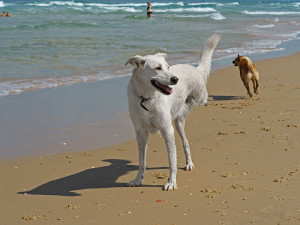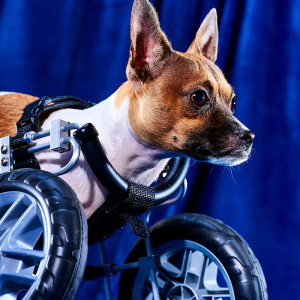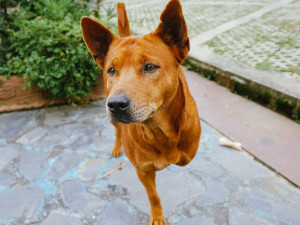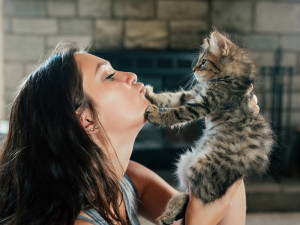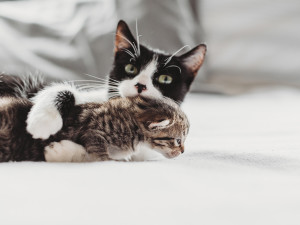Meet This Inspiring Online Community of Parents to Three-Legged Pets
“We learned dogs are born with three legs and a spare.”

share article

Your pet wants you to read our newsletter. (Then give them a treat.)
In February, two weeks after he returned to his old seat as a host on The Daily Show, comedian Jon Stewart shared that his dog, Dipper, a three-legged Brindle Pit Bull, had died. He didn't get far into his monologue about Dipper, who had lost his right leg after being hit by a car as a puppy, before Stewart began to visibly tear up. (The internet also collectively weptopens in a new tab.)
“In a world of good boys, he was the best,” Stewart said about Dipper, whom Stewart’s family adopted from New York City rescue Animal Haven opens in a new tab12 years ago. He concluded with this sweet message: “Boy, my wish for you is one day you find that dog, that one dog that just…it’s the best.”
Rene Agredano and Jim Nelson, founders of an online tripod-parent community called Tripawdsopens in a new tab, found their own version of “that dog” in Jerry G. Dawgopens in a new tab, a puppy they adopted in 2006. When Jerry was eight years old, veterinarians diagnosed him with terminal bone cancer and gave him four months to live. The diagnosis crushed Agredano and Nelson. “We didn’t know about canine canceropens in a new tab, amputation, surgery, or tripod dogs,” Agredano says.
The couple relied on Jerry’s veterinarians and decided to go ahead and have his front leg amputated to remove the cancer. “When I picked him up after the surgery, the first thing I noticed was a huge smile on his face,” Agredano says. “He was happy to see us. Removing the cancer in his leg removed the pain.” Jerry was able to run, fetch, and live a happy life on three legs.
“We learned dogs are born with three legs and a spare,” Nelson adds. “Dogs live in the present ... Life looks different on three legs.”
On the road
AfterJerry's surgery, Agredano and Nelson started blogging about life with their three-legged dog, which helped them connect with many other tripod pet parents.
Agredano and Nelson then decided to adopt another tripod, Wyatt Ray, a German Shepherd who lost his leg while chained to a post in a yard. Wyatt tried numerous times to free himself, and the chain wrapped around his leg and cut off his circulation. He had a rough start, to say the least, but he and his parents had plenty of support, thanks to their Tripawds community.
To further spread their blog’s message, Agredano, Nelson, Jerry, and Wyatt took a road trip covering 30,000-plus miles in an RV. They talked to people they met about their tripods. Others asked and answered questions, and their blog membership grew. Today, there are 23,000 Tripawd members. Their motto is “It’s better to hop on three legs than limp on four!”
Surpassing expectations
When passersby on the street see Vibeke Alstad Jagne and her husband walking their tripod, Nora, they point and say, “Oh, no; a three-legged dog.” Once they spot her running, their comments change to “Wow!”
Nora was supposed to be a foster dog. She’s a Middle Eastern Village Dog from Iran. Someone cut off part of her front right leg with a chainsaw.
“Losing a front leg is harder than losing a hind leg,” Alstad Jagne says. “Dogs carry 60 percent of their weight on their front legs. That didn’t stop her from running and playing. She’s happy go lucky. Watching her run and move about amazes us.”
Nora came to the States from an Iranian pet rescue and Beagle Freedom Projectopens in a new tab. (Beagle Freedom Foundation usually rescues beagles and other lab dogs and cats. Nora was a special case because of her injuries.) She was all set to live in a foster home until something even better came along. The foster volunteer backed out, and Beagle Freedom Project called Alstad Jagne, asking if she knew anyone who could foster the then two-year-old Nora.
Nora’s first stop in the States was at the Animal Medical Center in New York City to amputate her infected stump. After the surgery, Alstad Jagne and Jackson decided to officially adopt Nora.
Alstad Jagne, who runs the dog-training company Sit Hits the Fanopens in a new tab, and her husband have two rescue cats. “A few years before adopting Nora, our Great Dane died,” she says. “We just moved into a house with our cats and were ready to adopt. The goal was to foster because we never lived with a tripod before. Rene and Jim (Agredano and Nelson) were incredibly helpful, as was the Tripawd community.” Alstad Jagne adds that Nora, who is now 10, gets along great with the cats.
Like other dogs, she plays and even jumps on the furniture. She’s not allowed to go on the stairs by herself, so Alstad Jagne or her husband carry her upstairs when they go to bed. A gate at the top of the stairs prevents her from trying to go down alone and falling. “When she wants to go down, she waits for us at the top of the stairs,” Alstad Jagne says.
In an adorable display of representation, all of Nora’s favorite plush toys also have three legs, courtesy of Nora herself. “She chewed off the leg of her first toy, and I didn’t think too much about that until she did it to her other plush toys,” Alstad Jagne says.
Such a good dog
Mona Patel, a lawyer with the LA Philharmonic, also makes sure her tripod, Cash (short for Cashew), a Golden Retriever / Labrador, gets lots of exercise and stays in shape. “Labs are water dogs,” she says. “Cash loved swimming, playing in the snow, and participating in other sports.” He often trained beside Patel when she participated in several ironman competitions.
At age 11, Cash received a cancer diagnosis on his back right leg. After two surgeries to remove the tumor, the veterinarian recommended amputation. “We wanted him pain-free and to be with us for as long as possible,” Patel says.
She Googled “amputation” and “pet cancer,” and Tripawds surfaced. “We were so glad to find Rene and Jim,” she says. “The site covers everything one needs to know about life with a tripod dog or cat.”
Tripawd’s website contains information about pet products, such as wheelchairs, food, toys, beds, and information about pet nutrition, exercise, and care. She asked questions about living in a multiple-story home. Patel’s home is four stories with lots of steps, like the house the pup Nora lives in. Cash lives on the first floor so he doesn’t take a tumble down the stairs.
Cash lived to be 13. “Every day with him was a gift,” Patel says.
A balancing act
Stefanie Comerford, a healthcare worker in Charlotte, NC, agrees tripods teach their parents about happiness. She adopted her orange tabby, Dexter, when he was about 18 months old. One day, when Dexter was 11, Comerford felt a mass on his leg while she was holding him.
“Cats hide their painopens in a new tab,” she explains. “I noticed he wasn’t putting any weight on it. Something wasn’t right.”
A veterinary visit and X-rays found a lump, which turned out to be cancer. Dexter’s veterinarian recommended amputation. A friend who rescues cats recommended she reach out to Tripawds. “Other tripod cat parents answered my questions and put my mind at ease,” she says. “I learned cats rely on their front legs more than their rear legs. When they jumpopens in a new tab, they often land on their front legs first.”
After the surgery, Dexter relearned how to navigate on three legs. Comerford helped him by placing small steps by the side of her bed and alongside counters, so the jump down wasn’t too high.
Dexter’s new litter boxopens in a new tab had no cover and low sides to make stepping into and out of it easy. “He was more upset wearing the cone,” she says. “Dexter is a big groomer, and he likes having his neck scratched. I removed the cone while he ate and kept it off so he could groom himself. Then I put it back on to keep him from tearing at the stitches.”
A month after the surgery he was back to normal. “He’s playful and happy,” Comerford says, adding that Dexter uses his scratching post, climbs up on his cat tree, and balance on his hind leg.
She continues: “He didn’t let this stop him. I thought about that a lot. As humans, we complain about everything. Animals have to figure out their next move and move forward. Watching him is an awesome reminder that we need to appreciate life.”
How to help Tripawds
Thankfully, veterinary visits for dogs with three legs don’t differ from care for dogs or cats with four legs, but cancer treatments cost a pretty penny. The Tripawds Foundationopens in a new tab welcomes donations to assist pet parents facing a cancer diagnosis and/or amputation for their pets.
And if you can‘t help financially, you can encourage others to adopt or foster a three-legged dog. Just like Jon Stewart did with his emotional Dipper story, you’ll be helping others realize just how special these pups really are.

Michele C. Hollow
Michele C. Hollow has written for The NY Times, AARP, and NJ Monitor. She writes about animals and health. All of her cats were former strays who found her. She has a middle grade book coming out this September.
Related articles
![Henry Friedman and Bunny’s new/custom wheelchair from Mercedes Benz.]() opens in a new tab
opens in a new tabHow Bunny the Dog Got the Literal Mercedes-Benz of Wheelchairs
Rescuer Henry Friedman helped a disabled dog go from abandoned on the street to rocking a designer whip.
![A brunette woman holding a spotted gray kitten up to her face while its front paws rest on her chin]() opens in a new tab
opens in a new tab10 Foster-Fail Stories That Will Tempt You to Do the Same
Adopting a foster pet doesn’t isn’t always the right choice. But for these families, it turned out to be the only one.
- opens in a new tab
Should I Adopt a Young or Adult Pet?
Age isn’t always just a number.
![A woman in a bright yellow-orange sweater holding a striped kitten in one hand and a credit card in the other while using her laptop in front of her]() opens in a new tab
opens in a new tabCan’t Pay Your Pet’s Vet Bills? These Orgs Can Help
When the bills rack up, these resources have your back.
![Saharai “Sada” Salazar and a large Belgian Malinois dog who is part of the Wolfmother K9 Rescue.]() opens in a new tab
opens in a new tabThe Fiction of “Unadoptable” Shelter Dogs
Wolf Mother K9 founder Saharai Salazar on misunderstood behaviors, giving every pup a chance, and the need for more empathy.
